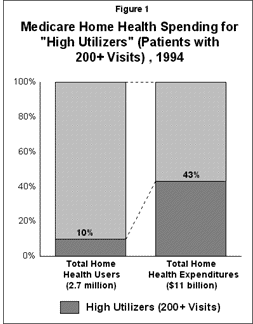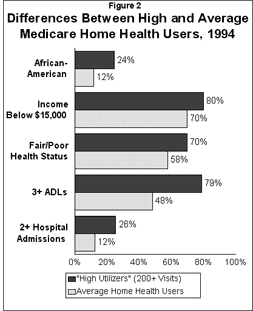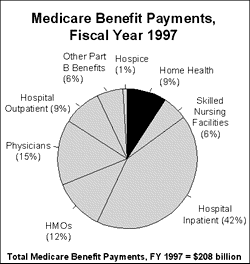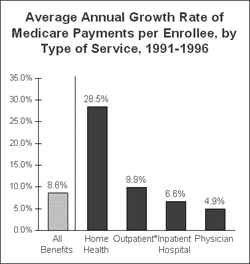Children’s Health Insurance: 1997 Budget Reconciliation Provisions
(as of 07/14/1997)
Center of Health Policy Research and The George Washington University Medical Center
Current Law And StatusHouse BillSenate BillI.Status Recommendations transmitted 06/12/97 from Commerce Committee to Budget Committee. H.R. 2015 passed House 06/25/97. Recommendations transmitted 06/19/97 from Finance Cte to Budget Cte. H.R. 2015 (spending bill) and H.R. 2014 (tax bill) as passed by the Senate 06/25/97 and 06/27/97. II.General Approach No systematic approach to financing health coverage for children. Coverage is through employer-sponsored private insurance, publicly-subsidized private plans, and Medicaid.
In 1994 among children under age 18:
- 14% (10 million) were uninsured;
- 61% had private coverage; and
- 18% had only Medicaid coverage.
The percentage of uninsured children varied by income, with no coverage among:
- 22% of poor children (with family income below 100% FPL);
- 45% of near-poor children (with family income between 100-200% FPL);
- 9% of those with higher income.
Most uninsured children live in working families with incomes <250% FPL.
One third of uninsured children are eligible for Medicaid but not enrolled. Children’s Health Insurance
Child Health Assistance Program (CHAP) creates an entitlement in states, but not in individuals.
Entitles states to payments ($14 billion over five years) to cover uninsured, low income children using any or all of the following methods:
- provision of benefits under Medicaid;
- purchase of private (self-insured/insured group or individual) coverage;
- direct purchase of services;
- other methods as specified by the state.
Requires states to submit to HHS a plan describing use of funds, with approval of the plan triggering state eligibility for payments.
Requires state plans to follow federal framework on eligibility, benefits, cost-sharing, and other matters.
Effective October 1, 1997.
Number of children covered under CHAP = 500,000 previously uninsured children (CBO estimate).
Medicaid
Permits states to speed up the current mandatory phase-in of Medicaid coverage for children born after September 30, 1983 who are under age 19 and whose family income is below 100% FPL. Children covered = 125,000 (CBO estimate).
Allows states the option to provide 1 year of continuous coverage under Medicaid for children under 19 ($0.7 billion over five years). Children covered = 130,000 (CBO estimate).
Permits states to provide Medicaid during a presumptive eligibility period for children under 19 years old ($0.5 billion over five years). Children covered = 110,000 (CBO estimate).
Total number of children covered = 865,000 previously uninsured children (CBO estimate). Children’s Health Insurance
Children’s Health Insurance Initiatives creates an entitlement in states, but not in individuals.
Entitles states to payments ($16-$24 billion over five years) to cover uninsured, low income children using one of two methods:
- expansion of Medicaid; or
- purchase or provision of children’s health insurance through a grant program.
Requires states to carry out outreach activities to enroll children who are eligible for Medicaid and to encourage employers to provide health insurance coverage for children.
Requires states to submit to HHS a program outline identifying which one of the two options the state intends to use.
Effective October 1, 1997.
Medicaid
To qualify for new funds, states must speed up (by 2000) the current mandatory phasing-in of Medicaid coverage for children born after September 30, 1983 who have not reached the age of 19 and whose family income is below 100% FPL.
Allows states the option to provide 1 year of continuous coverage under Medicaid for children under age 19.
Total number of children covered = 1,670,000 previously uninsured children (CBO estimate). III.Coverage Rules Eligibility and coverage rules vary with type of plan (e.g., employer-based plan, Medicaid, state insurance program).
States have an option to extend Medicaid to all uninsured children. Five states cover children under age 18 or 19 in near-poor families with incomes up to 185% FPL or higher. Defines low income children as children who are under 19 years old and whose family income is below 300% FPL.
Further defines targeted low-income children as those who:
- are determined eligible for assistance under the program;
- have family income above the applicable Medicaid level in the state but not exceeding an income level that is 75% greater than the Medicaid applicable level, or, if higher, 133% FPL; and
- are not eligible for Medicaid or covered under a group plan or other private insurance.
Prohibits discrimination on the basis of diagnosis or denial of eligibility on the basis of a preexisting medical condition, although group health plans may continue to exclude coverage of preexisting conditions as under current law.
Permits states to establish coverage standards based on age, income, resources, disability status, duration of eligibility and geographic area. Within each category, states must give priority to children with lower family incomes.
Requires state plans to include a description of:
- the methods (including a methodology consistent with Section 1902(1)(3)(E)) to establish and continue eligibility and enrollment; and
- the procedures to screen for eligibility, coordinate coverage with Medicaid and other insurance programs, and avoid substitution of private coverage by the new assistance provided by the state.
Defines low income children as children who are under 19 years old and whose family income is below 200% FPL.
Permits states to establish coverage standards with priority to children with lower family incomes.
Requires program outlines to include a description of
- the standards and methodologies used to determine eligibility; and
- the procedures used to screen for eligibility, coordinate coverage with other programs, and avoid substitution of private coverage by the new assistance provided by the state.
IV.Premium Assistance Requires that, to the extent possible, states set individual premiums on a income-based, sliding scale, giving priority to children in lower income families.
Any state payments (in the form of cash or vouchers) would not be counted as income for purposes of determining eligibility for any means-tested federal or federally-assisted program (e.g., food stamps). Permits states to impose premiums on families with incomes above 150% FPL.
Imposes same limits on beneficiary costs as Medicaid for those below 150% FPL (i.e., no cost-sharing for mandated populations, but nominal cost-sharing for optional populations). V.Benefit Structure Medicaid’s EPSDT program covers comprehensive benefits for children, including: medical, dental, preventive, primary, hospital, specialty, developmental, and long term care services.
Employer plans vary in scope of benefits, with most including preventive, primary, and inpatient services and few covering developmental or long term care services.
Special state programs and private insurance plans for children vary in scope of benefits; most have preventive and primary care, but many do not include inpatient or long term care services. Requires states to cover at least four categories of services:
- inpatient and outpatient hospital services;
- physician surgical and medical services;
- laboratory and x-ray services; and
- well-baby and well-child care, including age-appropriate immunizations.
Requires states to specify:
- amount, duration and scope of benefits;
- level of cost-sharing, including premiums, deductibles, coinsurance and other cost-sharing;
- delivery method (e.g., fee-for-service, managed care, direct service provision, vouchers); and
- utilization control systems.
Group plans are exempt from covering the minimum categories of benefits if they provide the same coverage to children eligible for assistance as provided to other individuals covered by the group plan.
Prohibits states from using funds to pay for abortions or to assist in the purchase of benefits that include coverage of abortion except in cases of rape, incest, or danger to the mother. Requires states using the grant program to provide benefits at least equivalent to the Blue Cross/Blue Shield standard PPO option under Federal Employee Health Benefit Plan (FEHBP), including dental, vision and hearing. The Secretary of HHS will certify that plans are equivalent or better than this standard FEHBP benefit package.
Requires parity in mental health coverage if insurers offer such coverage.
Prohibits states from using funds to pay for abortions or to assist in the purchase of benefits that include coverage of abortion except in cases of rape, incest, or danger to the mother. VI.Cost-Sharing Prohibits states from imposing cost-sharing on preventive services. Permits states to impose cost-sharing requirements on families with incomes above 150% FPL. Imposes same limits on beneficiary costs as Medicaid for those below 150% FPL. VII.Insurance Reforms Prohibits states from permitting the use of any preexisting condition exclusion for covered benefits.
Group plans are exempt from preexisting conditions requirements so long as they are in compliance with the Health Insurance Portability and Accountability Act (HIPAA) of 1996. Not specified. VIII.Treatment of Medicaid Medicaid coverage mandated for:
- persons who meet AFDC income rules as of 07/16/96;
- children born after 09/31/83 with family income <100% FPL;
- children below age 6 with income <133% FPL;
- infants of mothers covered by Medicaid;
- others (e.g., SSI, foster care).
Optional groups:
- infants with family income <185% FPL;
- children ages 13-21 with income <100% FPL;
- other children under liberalized income eligibility criteria (1902 (r)(2)).
No cost-sharing for children’s services.
States have an option to extend Medicaid to all uninsured children. Five states cover children under age 18 or 19 in near-poor families with incomes up to 185% FPL or higher. Phase-In Of Poor Children
Permits states to speed up the current mandatory phase-in of Medicaid coverage for children born after September 30, 1983 who have reached age 6 and whose family income is below 100% FPL. (Under the current mandatory phase-in schedule, all poor children under 19 will be eligible for Medicaid by the year 2002).
Eligibility
Permits states to use new funds available under the child health assistance program with an enhanced federal match to expand Medicaid eligibility under the following conditions:
- income and resource standards are not more restrictive than those applied as of 06/01/97;
- reporting of information to HHS about expenditures and payments for the expansion is provided for; and
- amount of increased payments does not exceed total amount of allotment not otherwise expended.
Outreach And Enrollment
Requires state plans to describe:
- outreach efforts to inform eligible families about assistance under the new program or other public or private coverage and to assist them in the enrollment process; and
- coordination strategies for the administration of the child health assistance program and other public and private insurance programs.
Continuous Coverage
Permits states to provide 12-month continuous coverage under Medicaid for children under 19.
Presumptive Eligibility
Permits states to provide Medicaid during a presumptive eligibility period for children under 19 years old; coverage financed through the state allotment for the child health assistance program.
Reductions In Federal Grant
Reduces federal grants to states based on costs related to presumptive eligibility. Phase-In Of Poor Children
To qualify for new funds, states must complete the phase-in of Medicaid to provide coverage for all children under age 19 whose family income is below 100% FPL by 2000. The phase-in can be staggered: under 17 by 1998 and under 19 by 2000.
Eligibility
Permits states to use new funds available under the child health assistance program to expand Medicaid with an enhanced federal match for children in eligibility expansion group.
Outreach And Enrollment
Funds set aside for states to carry out outreach activities, including:
- identification and enrollment of Medicaid eligible children; and
- conduct of public awareness campaigns to encourage employers to provide health insurance coverage.
Requires states to coordinate coverage with other programs (e.g., Medicaid).
Continuous Coverage
Permits states to provide 12-month continuous Medicaid coverage for children under age 19 for 1 year after eligibility is determined (option would trigger coverage of other Medicaid-eligible populations).
Maintenance Of Medicaid Effort
Requires state maintenance-of-effort according to which states must maintain:
- children’s Medicaid eligibility rules in place as of 06/01/97; and
- same amount of children’s health expenditures (i.e., Medicaid, Title V, school based services, etc.) as FY 96.
Reductions In Federal Grant
Reduces federal grants to states based on costs related to three aspects of Medicaid expansion:
- providing 12-month continuous eligibility;
- increased enrollment as a result of outreach; and
- accelerating phase-in of all poor children.
IX.Treatment of Employer-Based Coverage Permits states to deny benefits under the child health assistance program if other private coverage is available.
Exempts group plans from covering the minimum categories of benefits if they provide the same coverage to children eligible for assistance as provided to other individuals covered by the group plan. Permits group plans to impose preexisting condition exclusions so long as they are in compliance with HIPAA.
Requires HHS to establish rules for payment of family coverage under group plans. Permits payment if state demonstrates that purchase of that coverage is cost effective relative to the purchase of comparable coverage limited to targeted low income children. Provides FEHBP-equivalent coverage.
Requires states to avoid substitution of private coverage by the new assistance provided by the state. X.Children with Special Health Care Needs Requires states to ensure access to specialty care, including the use of a specialist as a primary care provider, for eligible children who have a chronic condition, a life-threatening condition, or a combination of conditions warranting such care. Provides for financial parity of mental health coverage if insurers offer such coverage. XI.State Role in Program Administration Multiple approaches to financing children’s health insurance.
States administer Medicaid. In general states determine the eligibility process, payment levels, providers, etc. State Medicaid programs use options and waivers to further modify program eligibility categories, benefits, payments, and provider types.
Over 30 states operate child health insurance initiatives including premium subsidy programs, insurance pools, and Medicaid optional expansions. States may choose to cover uninsured, low income children using any or all of the following methods:
- provision of benefits under Medicaid;
- purchase of private (self-insured/insured group or individual) coverage;
- direct purchase of services;
- other methods as specified by the state.
Requires states to prepare a plan in compliance with federal requirements and to submit it to HHS for approval.
Gives states the flexibility to design a child health assistance program within broad federal guidelines.
Requires states to set up a process to involve the public in the design and implementation of the plan as well as to ensure ongoing public involvement.
Mandates state spending to match federal allocation.
Requires states to collect data, maintain records and furnish reports to HHS for monitoring of administration and compliance as well as evaluation and comparison of state plan effectiveness.
Requires states to submit an evaluation to HHS by March 31, 2000 that would include:
- assessment of the effectiveness of the state plan in increasing coverage;
- description and analysis of the characteristics of children and families covered, the quality of coverage, the amount and level of assistance provided by the state, the plan service area, coverage time limits, choice of insurers, and sources of non-federal funding;
- assessment of the effectiveness of other public and private programs in increasing coverage;
- review of activities to coordinate the state plan with other programs, including Medicaid and maternal and child health services;
- analysis of changes and trends that affect health insurance and health care for children in the state;
- description of any activities to improve the availability of health insurance and care for children; and
- recommendations for improving the child health assistance program.
Denies payments to states in the following cases:
- if state modified income or assets standards or methodology in place as of 06/01/97;
- if services were furnished by providers excluded from participation under Title V, XVIII, XX, or new Title XXI, except for emergency services other than hospital emergency room services;
- if insurer that would have been obligated to provide assistance limited or excluded obligation in a provision of the insurance contract because of the child’s eligibility for assistance under the state plan;
- if state plan is a secondary payer to other federally operated or financed health care insurance programs (with the exception of the Indian Health Service), which could have been expected to pay;
- if state paid for abortions or assisted in the purchase of benefits that include coverage of abortion except in cases of rape, incest, or danger to the mother.
States may choose to cover uninsured, low income children using one of two methods:
- expansion of Medicaid; or
- purchase or provision of children’s health insurance through a grant program.
Requires states to prepare a program outline in compliance with federal requirements and to submit it to HHS for approval.
Gives states the flexibility to design a grant program within broad federal guidelines.
Mandates state spending to match federal allocation.
Requires states to submit annual progress reports to HHS.
Denies payments to states in the following cases:
- if state modified income or assets standards or methodology in place as of 06/01/97; and
- if states decreased amount of all types of children’s health expenditures below FY 96 levels.
Requires maintenance-of-effort according to which states must maintain
- children’s Medicaid eligibility rules in place as of 06/01/97; and
- same amount of children’s health expenditures (i.e., Medicaid, Title V, school based services, etc.) as FY 96.
XII.Allocation and Distribution of Funds to States Federal-state entitlement funding for Medicaid, in which a set federal contribution is made to states for each dollar spent – known as federal matching (FMAP).
Employers have tax deduction for contributing to employee health benefits. Typically, employees make a contribution to health benefit costs. Some employers “self-insure” under ERISA, (i.e. they assume the risk associated with health insurance rather than buying coverage from an insurance company). Federal Matching
For expanded coverage of children through Medicaid the Enhanced FMAP = FMAP + [30% x (100-FMAP)].
For expanded coverage of children through grant program, provides for quarterly payments by HHS not to exceed 80% of state expenditures.
Allocation Of Funds
Entitles each state to receive a yearly minimum allotment of $2 million (each territory: $100,000).
Ratio for allotments = (Number of uncovered low income children for a fiscal year in the state1 x State cost factor2)/(Sum of the products in numerator)
Reduces the allotment of states opting for the increased Medicaid matching option by the amount of additional payment made under Medicaid that is attributable to the increase in the federal medical assistance percentage.
Authorized Expenditures
Permits payments for:
- child health assistance;
- health services initiatives to improve the health of children;
- outreach activities; and
- other reasonable costs incurred to administer the program.
Caps payments for health services initiatives to improve the health of children, outreach activities, and other reasonable costs incurred to administer the program at 15% of total program expenditures.
Gives states three years to expend the money under the child health assistance program.
Reductions In Federal Grant
Reduces federal grants to states based on costs related to presumptive eligibility. Federal Matching
Defines bonus amount as:
- 5% of the cost of providing health insurance to the base year child population who are being covered at state option (paid out of the basic allotment pool); and
- 10% of the cost of providing health insurance to additional children who are being covered at state option (paid out of the coverage incentive pool).Provides for quarterly payments by HHS in an amount equal to the federal medical assistance percentage of the cost of providing coverage to low income children in the state through either option augmented by a bonus amount. Total amount paid to an eligible state should not exceed 85% of the total cost of the state program.
Allocation Of Funds
Entitles states to receive a base allotment.
Allotment percentage = (Number of low-income children in the base period in the state3)/(Total number of low income children in the base period in all states)
Creates two financing pools:
- basic allotment pool (85% of funds after deduction for Medicaid outreach, continuous coverage and phase-in); and
- coverage incentive pool (15% of funds after deduction for Medicaid outreach, continuous coverage and phase-in)
Permits HHS to adjust the 85/15 split annually.
Authorized Expenditures
Permits payments for:
- health insurance assistance for eligible children through Medicaid or grant program;
- outreach activities; and
- administrative costs (10% of total expenditures in FY 98-99; 7.5% in FY 2000; 5% in FY 2001).
Prohibits use of funds for:
- families of state public employees; or
- children who are committed to a penal institution.
Gives states three years to expend the money.
Reductions In Federal Grant
Reduces federal grants to states based on costs related to three aspects of Medicaid expansion:
- providing 12-month continuous eligibility;
- increased enrollment as a result of outreach; and
- accelerating phase-in of all poor children.
XIII.Estimated Cost $16 billion over 5 years:
- $14 billion over 5 years for child health assistance program; and
- $2 billion over 5 years for Medicaid provisions.
$16-$24 billion over 5 years for children’s health insurance initiatives, with $8 billion through 20 cents/pack increase in the cigarette tax. 1 Defined as the arithmetic average of the number of low income children (i.e., children whose family income is below 300% FPL) with no health insurance coverage as reported in the three most recent March supplements to the Current Population Survey before the beginning of the fiscal year.
2 Defined as (.15) + [(.85) x (annual average wages per employee for the state for a fiscal year/annual average wages per employee for the 50 states and D.C.)].
3 Defined as the average number of low income children in the state between 10/01/92 and 09/30/95 as reported in the March 1994, 1995, and 1996 supplements to the Current Population Survey.
For easy printing of this document, download the  PDF version of “Children’s Health Insurance: 1997 Budget Reconciliation Provisions” and adjust your printer setup for “landscape” printing.
PDF version of “Children’s Health Insurance: 1997 Budget Reconciliation Provisions” and adjust your printer setup for “landscape” printing.
For more information on Medicare and Medicaid Provisions being reviewed by Congress, see:
- Overview Of Selected Medicare Provisions: A Side-by-Side Comparison of Medicare Current Law with House and Senate Provisions to the Balanced Budget Act of 1997

- A Comparison of the Medicaid Provisions in the House and Senate Versions of the Balanced Budget Act of 1997 (H.R. 2015/S. 947) with Current Law

- Side-By-Side Comparison Of Proposed Federal Legislation For Consumer Protection In Managed Care Plans

Return to Top




